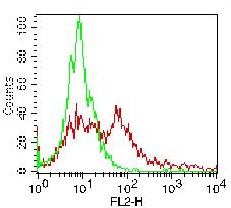Human OLR1 / LOX1 Recombinant Protein (His Tag)(Discontinued)
Shipping Info:
For estimated delivery dates, please contact us at [email protected]
| Amount : | 100 µg |
| Purification : | > 85 % as determined by SDS-PAGE |
| Content : | Formulation Lyophilized from sterile PBS, pH 7.4 Normally 5 % - 8 % trehalose, mannitol and 0.01% Tween80 are added as protectants before lyophilization. |
| Storage condition : | Store it under sterile conditions at -20°C to -80°C. It is recommended that the protein be aliquoted for optimal storage. Avoid repeated freeze-thaw cycles. |
| AA sequence : | Ser61-Gln273 |
| Alternative Name : | CLEC8A Protein, LOX1 Protein, LOXIN Protein, OLR1 Protein, SCARE1 Protein, SLOX1 Protein, |
Source : HEK293 Cells
Oxidized low-density lipoprotein receptor 1 (Ox-LDL receptor 1 or OLR1), also known as lectin-type oxidized LDL receptor 1 (LOX1), is a receptor protein that belongs to the C-type lectin superfamily. LOX1 is a multi-ligand receptor originally identified as the endothelial oxidized LDL receptor. OLR1 / LOX1 was isolated from an aortic endothelial cell, and recently it has been discovered in macrophages and vascular smooth muscle cells in artery vessels. The expression of LOX1 is inducted by inflammatory stimuli and oxidative stimuli. This protein binds, internalizes and degrades oxidized low-density lipoprotein. LOX1 may play an important role in the progression of vulnerable carotid plaque and might regulate vulnerable plaque formation in cooperation with MMPs and TIMP-2. In clinical, LOX1 is thought to be involved in the development of atherosclerotic lesions.
Oxidized low-density lipoprotein receptor 1 (Ox-LDL receptor 1 or OLR1), also known as lectin-type oxidized LDL receptor 1 (LOX1), is a receptor protein that belongs to the C-type lectin superfamily. LOX1 is a multi-ligand receptor originally identified as the endothelial oxidized LDL receptor. OLR1 / LOX1 was isolated from an aortic endothelial cell, and recently it has been discovered in macrophages and vascular smooth muscle cells in artery vessels. The expression of LOX1 is inducted by inflammatory stimuli and oxidative stimuli. This protein binds, internalizes and degrades oxidized low-density lipoprotein. LOX1 may play an important role in the progression of vulnerable carotid plaque and might regulate vulnerable plaque formation in cooperation with MMPs and TIMP-2. In clinical, LOX1 is thought to be involved in the development of atherosclerotic lesions.
Endotoxin :< 1.0 EU per µg of the protein as determined by the LAL method
For Research Use Only. Not for use in diagnostic/therapeutics procedures.
|
There are currently no product reviews
|






















.png)








